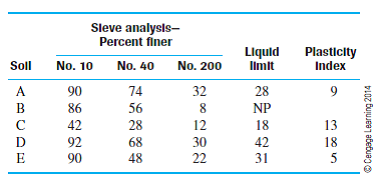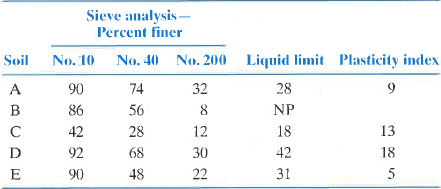


If r.upper() = "AASHTO" or r.upper() = "BOTH": Print( f'With PI below A-line and LL>50, fines are Silt with High Compressibility(MH)', " n ") If PIA 50, fines are Clay with High Compressibility(CH)') Print( f'With PI above A-line and LL PI and PI 50: R = input( 'Name of the classification required? (AASHTO/USCS/Both): ')Ī = float(input( 'Material % finer than sieve #200 size(0.075mm): ')) The result will show the USCS classification of the soil. The AASHTO Soil Classification System was developed by the American Association of State Highway and Transportation Officials, and is used as a guide for the classification of soils and soil-aggregate mixtures for highway construction purposes. Put all the data given your problem, as and when asked. When you run the code, it will ask you to enter the inputs related to the soil properties such as #200 sieve % finer, #4 finer etc. Also, make sure to have ‘math’ library installed. Refer Table 4.1, Classification of Highway Subgrade Materials from the.
AASHTO MATERIAL CLASSIFICATION CODE
Clays have plasticity, silts do not as much.The following code is written in Python language, so to run the code you must have Python installed in your computer. The AASHTO system classifies soil on quality for using as subgrade material. AASHTO American Association of State Highway and Transportation Officials classification method was introduced for selecting soil for the construction of highways and road.Organic compounds are usually dark in soil, organics are bad for engineering soils.M and O classifications require identification by observation, color, and other testing,.Here are some pointers on where to go from here: There are a couple instances where you will run the numbers and parameters in either classification test but be left with an ambiguous soil. The geological classification allows cor- relation of soil and rock units across regions and their observed or predicted occurrence at a site. The Plasticity Index is used in both methods, in AASHTO to differentiate between A-7-5 and A-7-6 and in USCS it is the vertical axis on the plasticity chart. emphasizes origin, mineralogy, rock classification, lithology, techtonics, and structure, including forma- tion names. The Plasticity Index (PI) is equal to the Liquid Limit (LL) minus the Plastic Limit (PL):
AASHTO MATERIAL CLASSIFICATION HOW TO
#200 allows up to 0.075 mm grains to pass) and how to determine what percent of the soil passes through that sieve, find the charts for this in your reference. aashto soil classification (by aashto) aashto american association of state highway and transport officials situation 2 classification of highway subgrade materials finer soil b sieve general classification granular materials (35 or less of total sample passing no. You will need to be familiar with the sieve sizes (e.g. USCS classification returns a two-digit group symbol for the soil such as GW for gravelly well-graded, SM for silty sand, CL for low plasticity clay etc. This set of functions classifies soil using the American Association of State Highway and Transportation Officials (AASHTO) Soil Classification System. A-1 is the best all-round and A-8 is not really suitable for building. ble 4.2 Unified Soil on Material Sieve) criteria symbols Clean Gravels Gravels With. index is always reported as a non-negative integer value Group index is always zero for groups A-1, A-3, A-2-4, A-2-5 AASHTO. Silty or clayey soil belongs to A-2, whereas pure silty soils with minimum 36 fines fall into A-4 and A-5 groups. A-3 group consists of fine sand with a maximum of 10 fines. A-1 group consists of stone fragments, gravel, and sand with a maximum of 25 fines. Both methods involve finding the appropriate soil class given some parameters like passing a certain sieve size, liquid limit, plastic limit, significant makeup, and other ratings.ĪASHTO classification returns an A-1 through A-8 rating. 2 AASHTO AASHTO Low-plasticity SILTS High. As per the AASHTO classification, soils are divided into seven groups A-1 to A-7. There are two main methods of soil classification: AASHTO, and the Unified Soil Classificaiton System (USCS).


 0 kommentar(er)
0 kommentar(er)
